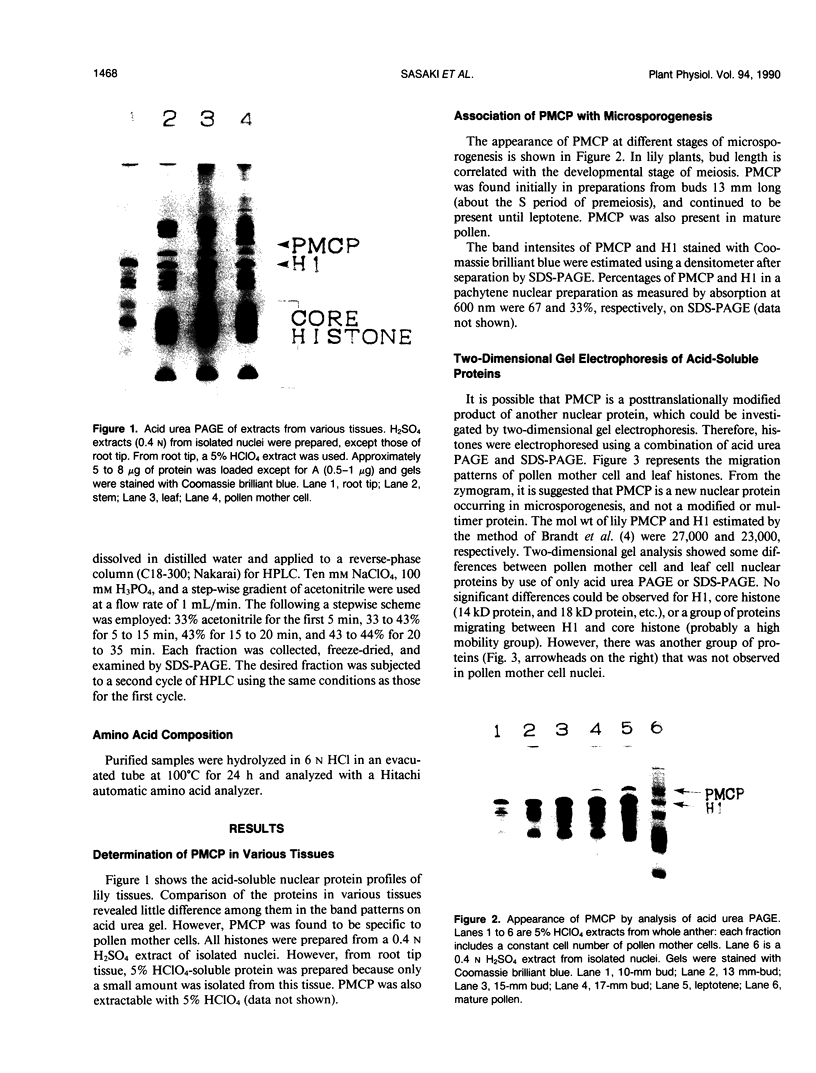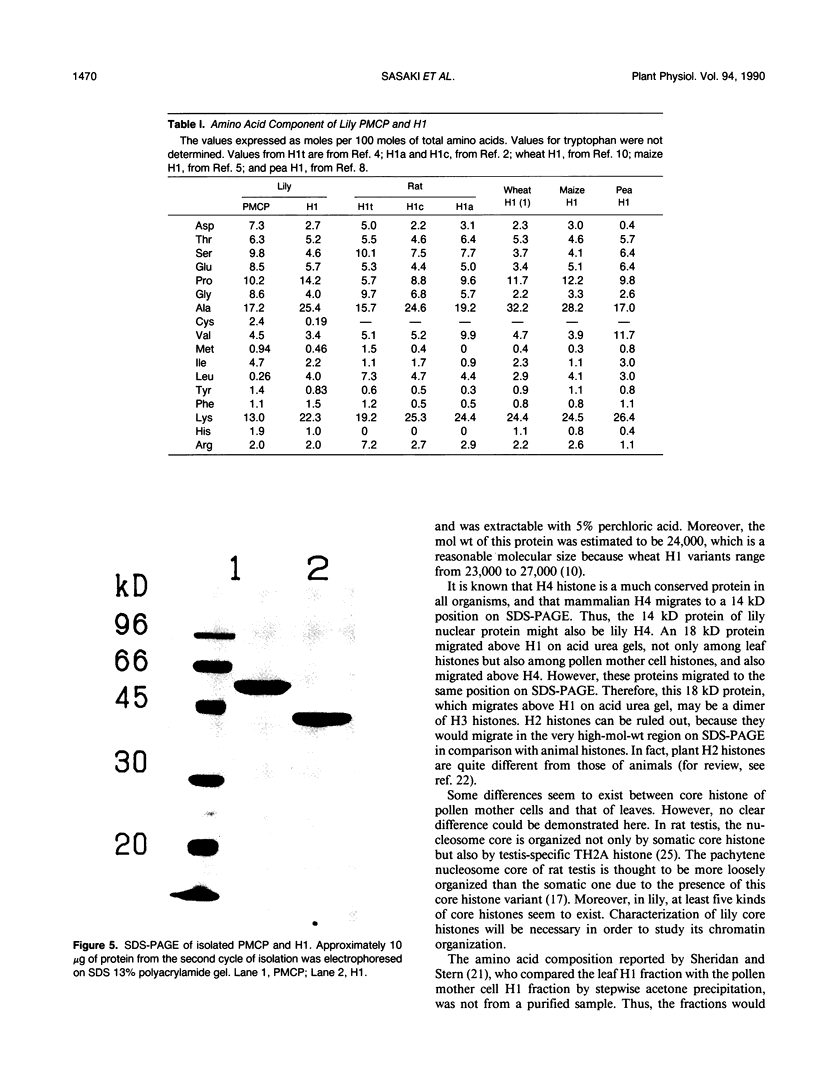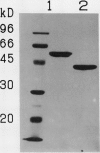Abstract
Pollen mother cells of the lily (Lilium speciosum) were found to have a histone-H1-like protein (PMCP) not detected in other tissues. The PMCP appears from the late S-G2 period of premeiosis and is present in mature pollen. PMCP and H1 were extracted from pollen mother cells with 5% perchloric acid and isolated by reverse-phase high-performance liquid chromatography. The amino acid composition of PMCP differs from that of somatic H1. However, PMCP is similar to H1t in mammalian testis with regard to amino acid composition.
Full text
PDF




Images in this article
Selected References
These references are in PubMed. This may not be the complete list of references from this article.
- Alder D., Gorovsky M. A. Electrophoretic analysis of liver and testis histones of the frog Rana pipiens. J Cell Biol. 1975 Feb;64(2):389–397. doi: 10.1083/jcb.64.2.389. [DOI] [PMC free article] [PubMed] [Google Scholar]
- Allan J., Hartman P. G., Crane-Robinson C., Aviles F. X. The structure of histone H1 and its location in chromatin. Nature. 1980 Dec 25;288(5792):675–679. doi: 10.1038/288675a0. [DOI] [PubMed] [Google Scholar]
- Brandt W. F., Sewell B. T., von Holt C. Mr determination of histones from their electrophoretic mobility in acidic urea gels in the absence of detergents. FEBS Lett. 1986 Jan 6;194(2):273–277. doi: 10.1016/0014-5793(86)80099-0. [DOI] [PubMed] [Google Scholar]
- Gantt J. S., Key J. L. Molecular cloning of a pea H1 histone cDNA. Eur J Biochem. 1987 Jul 1;166(1):119–125. doi: 10.1111/j.1432-1033.1987.tb13490.x. [DOI] [PubMed] [Google Scholar]
- Hotta Y., Stern H. A DNA-binding protein in meiotic cells of Lilium. Dev Biol. 1971 Sep;26(1):87–99. doi: 10.1016/0012-1606(71)90110-2. [DOI] [PubMed] [Google Scholar]
- Hurley C. K., Stout J. T. Maize histone H1: a partial structural characterization. Biochemistry. 1980 Feb 5;19(3):410–416. doi: 10.1021/bi00544a002. [DOI] [PubMed] [Google Scholar]
- Kinkade J. M., Jr Qualitative species differences and quantitative tissue differences in the distribution of lysine-rich histones. J Biol Chem. 1969 Jun 25;244(12):3375–3386. [PubMed] [Google Scholar]
- Laemmli U. K. Cleavage of structural proteins during the assembly of the head of bacteriophage T4. Nature. 1970 Aug 15;227(5259):680–685. doi: 10.1038/227680a0. [DOI] [PubMed] [Google Scholar]
- Levinger L. F., Carter C. W., Jr, Kumaroo K. K., Irvin J. L. Cross-referencing testis-specific nuclear proteins by two-dimensional gel electrophoresis. J Biol Chem. 1978 Aug 10;253(15):5232–5234. [PubMed] [Google Scholar]
- Mezquita C., Teng C. S. Studies on sex-organ development. Changes in nuclear and chromatin composition and genomic activity during spermatogenesis in the maturing rooster testis. Biochem J. 1977 Apr 15;164(1):99–111. doi: 10.1042/bj1640099. [DOI] [PMC free article] [PubMed] [Google Scholar]
- Ninnemann H., Epel B. Inhibition of cell division by blue light. Exp Cell Res. 1973 Jun;79(2):318–326. doi: 10.1016/0014-4827(73)90450-3. [DOI] [PubMed] [Google Scholar]
- Panyim S., Chalkley R. High resolution acrylamide gel electrophoresis of histones. Arch Biochem Biophys. 1969 Mar;130(1):337–346. doi: 10.1016/0003-9861(69)90042-3. [DOI] [PubMed] [Google Scholar]
- Rao B. J., Brahmachari S. K., Rao M. R. Structural organization of the meiotic prophase chromatin in the rat testis. J Biol Chem. 1983 Nov 25;258(22):13478–13485. [PubMed] [Google Scholar]
- Seyedin S. M., Kistler W. S. H1 histone subfractions of mammalian testes. 1. Organ specificity in the rat. Biochemistry. 1979 Apr 3;18(7):1371–1375. doi: 10.1021/bi00574a038. [DOI] [PubMed] [Google Scholar]
- Seyedin S. M., Kistler W. S. H1 histone subfractions of mammalian testes. 2. Organ specificity in mice and rabbits. Biochemistry. 1979 Apr 3;18(7):1376–1379. doi: 10.1021/bi00574a039. [DOI] [PubMed] [Google Scholar]
- Seyedin S. M., Kistler W. S. Isolation and characterization of rat testis H1t. An H1 histone variant associated with spermatogenesis. J Biol Chem. 1980 Jun 25;255(12):5949–5954. [PubMed] [Google Scholar]
- Sheridan W. F., Stern H. Histones of meiosis. Exp Cell Res. 1967 Feb;45(2):323–335. doi: 10.1016/0014-4827(67)90183-8. [DOI] [PubMed] [Google Scholar]
- Strickland W. N., Strickland M., Brandt W. F., Von Holt C., Lehmann A., Wittmann-Liebold B. The primary structure of histone H1 from sperm of the sea urchin Parechinus angulosus. 2. Sequence of the C-terminal CNBr peptide and the entire primary structure. Eur J Biochem. 1980 Mar;104(2):567–578. doi: 10.1111/j.1432-1033.1980.tb04460.x. [DOI] [PubMed] [Google Scholar]
- Trostle-Weige P. K., Meistrich M. L., Brock W. A., Nishioka K., Bremer J. W. Isolation and characterization of TH2A, a germ cell-specific variant of histone 2A in rat testis. J Biol Chem. 1982 May 25;257(10):5560–5567. [PubMed] [Google Scholar]






